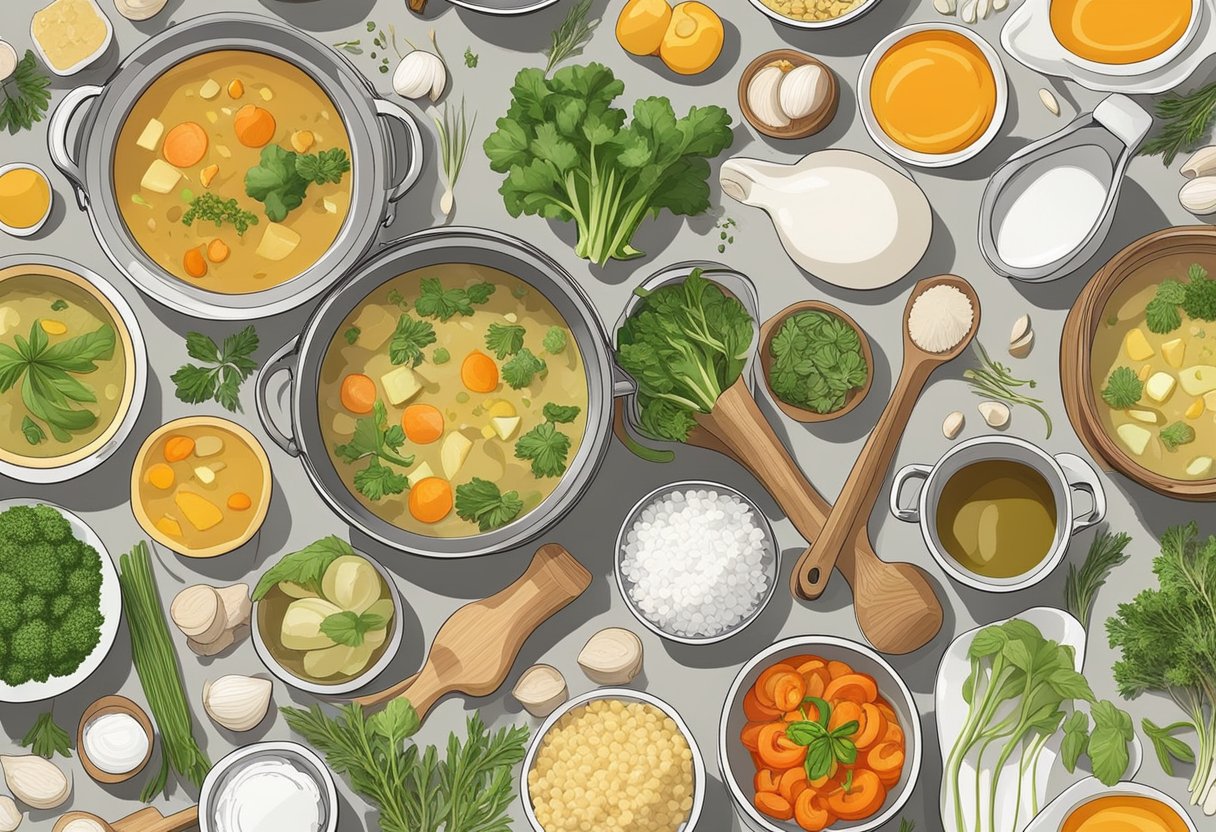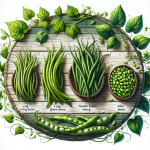Types Of Soup
Soup is a versatile and comforting food that has been enjoyed by people across the world for centuries. It is a dish that can be made with a variety of ingredients and prepared in different ways, making it a staple in many cultures. From hearty stews to light broths, there is a soup for every taste and occasion.
Soup Fundamentals
At its core, soup is a liquid dish that is typically made by simmering vegetables, meat, or fish in water or broth. The ingredients are often combined with herbs, spices, and other seasonings to enhance the flavor. Some soups are thick and hearty, while others are light and refreshing. The texture and consistency of the soup can be adjusted by varying the amount of liquid and the cooking time.
Popular Soup Types
There are countless types of soup that are enjoyed around the world. Some of the most popular varieties include chicken noodle soup, tomato soup, minestrone, and clam chowder. Each soup has its own unique flavor and ingredients, and many are associated with specific regions or cultures. For example, pho is a Vietnamese soup that is made with beef, rice noodles, and a fragrant broth, while borscht is a traditional soup from Eastern Europe that is made with beets, cabbage, and potatoes.
Key Takeaways
- Soup is a versatile and comforting food that can be made with a variety of ingredients and prepared in different ways.
- There are countless types of soup that are enjoyed around the world, each with its own unique flavor and ingredients.
- Soup can be a healthy and nutritious meal, depending on the ingredients and preparation methods used.
Soup Fundamentals

Ingredients
Soup can be made with a wide range of ingredients, including vegetables, meat, seafood, and grains. In general, soups are made by combining the ingredients with a liquid base, such as water or stock, and cooking them together until they are fully cooked and the flavors have melded together.
Stock and Broth
Stock and broth are the foundation for many soups. Stock is typically made by simmering bones and/or meat with vegetables and seasonings, while broth is made by simmering meat and/or vegetables with seasonings. Both are used to provide flavor and body to soups.
Soup vs Stew
While soups and stews are similar, there are some key differences. Soups are typically made with more liquid than stews, which are thicker and heartier. Stews also often include larger pieces of meat and vegetables, while soups are more likely to be pureed or have smaller pieces of ingredients.
When making soup, it is important to consider the balance of flavors and textures. Adding salt, herbs, and spices can help enhance the flavor of the soup, while adding cream or pureeing the soup can help create a smoother texture.
Overall, soup is a versatile and comforting dish that can be customized to suit a wide range of tastes and dietary needs. Whether you prefer a hearty stew or a light and brothy soup, there is sure to be a recipe out there that will satisfy your cravings.
Popular Soup Types
When it comes to soup, there are many different types to choose from. Some are creamy, some are chunky, and some are served cold. In this section, we’ll explore some of the most popular soup types and what makes them unique.
Broth-Based Soups
Broth-based soups are made by simmering meat, vegetables, and/or bones in water. The result is a flavorful broth that can be enjoyed on its own or used as a base for other soups. Chicken soup is a classic example of a broth-based soup, and it’s often used as a home remedy for colds and flu. Other popular broth-based soups include tomato soup, minestrone, and French onion soup.
Cream Soups
Cream soups are made by combining a roux (flour and butter) with broth and cream. The result is a thick, creamy soup that’s often pureed for a smooth texture. Cream of mushroom soup is a popular example of a cream soup, and it’s often used as a base for casseroles and other dishes. Other popular cream soups include broccoli cheddar and potato soup.
Chowders
Chowders are thick, chunky soups that are usually made with seafood or vegetables. New England clam chowder is a classic example of a chowder, and it’s made with clams, potatoes, and cream. Other popular chowders include corn chowder and seafood chowder.
Pureed Soups
Pureed soups are made by blending cooked vegetables or fruits with broth or cream. The result is a smooth, velvety soup that’s often served as a starter or a light meal. Gazpacho is a popular example of a pureed soup, and it’s made with tomatoes, cucumbers, and peppers. Other popular pureed soups include carrot soup and butternut squash soup.
Cold Soups
Cold soups are served chilled and are often made with fruits or vegetables. Gazpacho is a popular example of a cold soup, but there are many others to choose from. Some popular cold soups include cucumber soup, watermelon soup, and strawberry soup.
In conclusion, there are many different types of soup to choose from, each with its own unique flavor and texture. Whether you prefer a hearty chowder or a light pureed soup, there’s something for everyone. So why not try something new and discover your new favorite soup today?
Cultural and Regional Soups
Soup is a universal dish that has been enjoyed by people all over the world. Each country and region has its own unique take on soup, with different ingredients and preparation methods. In this section, we will explore some of the most popular cultural and regional soups.
American Classics
When it comes to American soups, there are a few classics that stand out. One of the most popular is chicken noodle soup, which is a comfort food that is often served when someone is feeling under the weather. Another classic is clam chowder, which is a creamy soup made with clams, potatoes, and sometimes bacon. Italian wedding soup is another American classic, which is a hearty soup that is made with meatballs, vegetables, and pasta.
European Delights
Europe has a rich history of soup-making, with many countries having their own unique recipes. French onion soup is a classic that is made with caramelized onions, beef broth, and topped with a slice of bread and melted cheese. Borscht is a popular soup in Eastern Europe, which is made with beets, cabbage, and sometimes meat. Minestrone soup is an Italian favorite, which is a vegetable soup that often includes beans, pasta, and sometimes meat.
Asian Specialties
Asian soups are known for their bold flavors and unique ingredients. Pho is a Vietnamese soup that is made with beef or chicken broth, rice noodles, and various herbs and spices. Miso soup is a Japanese staple, which is made with fermented soybean paste, tofu, and seaweed. Another popular Asian soup is Tom Yum, which is a spicy and sour soup that is popular in Thailand.
While there are many other cultural and regional soups out there, these are just a few examples of the diverse range of soups that can be found around the world. Whether you prefer a hearty bowl of soup on a cold winter day or a refreshing bowl of gazpacho on a hot summer day, there is a soup out there for everyone to enjoy.
Soup Preparation Techniques
Cooking Methods
There are many different methods for preparing soup, each of which can yield a unique flavor and texture. Some of the most common cooking methods include boiling, simmering, sautéing, and roasting. Boiling is perhaps the most straightforward method and involves cooking the soup ingredients in a pot of boiling water. Simmering involves cooking the soup at a lower temperature than boiling, which allows the flavors to meld together more slowly. Sautéing involves cooking the soup ingredients in a pan with a small amount of oil or butter, which can help to bring out their natural flavors. Roasting involves cooking the soup ingredients in an oven, which can help to caramelize their natural sugars and create a richer, more complex flavor.
Thickening Agents
Many soups require some form of thickening agent to achieve the desired texture. Some of the most common thickening agents include roux, cream, puree, and blended ingredients. Roux is a mixture of flour and fat that is cooked together and added to the soup to thicken it. Cream can be added to soups to give them a rich, velvety texture. Purees, such as those made from vegetables or legumes, can also be used to thicken soups and add flavor. Blended ingredients, such as potatoes or beans, can be pureed and added to the soup to give it a thicker, creamier texture.
Serving Suggestions
Soups can be served in a variety of ways, depending on the type of soup and the occasion. Some soups are best served hot, while others are best served cold. Noodle soups, such as chicken noodle soup, are often served with a side of bread or crackers. Dumpling soups, such as matzo ball soup, are often served with a side of rice or noodles. Cream soups, such as tomato soup, are often served with a garnish of fresh herbs or grated cheese. Lentil soups, such as lentil soup with sausage, are often served with a side of crusty bread. Pasta soups, such as minestrone, are often served with a side of garlic bread.
Health and Nutrition
Soup is a healthy and nutritious food that can provide a variety of benefits to one’s diet. Many types of soup contain an abundance of vegetables, which are rich in vitamins, minerals, and fiber. For example, lentil soup is an excellent source of protein and fiber, while tomato soup is a great source of vitamin C and lycopene.
In addition to vegetables, many soups are made with beans, which are high in protein and fiber. Carrots, onions, and celery are also common ingredients in soup and are a good source of vitamins and minerals.
Broth-based soups, such as chicken broth or beef broth, are low in calories and fat, making them a healthy option for those watching their weight. Seafood soups, such as clam chowder or shrimp bisque, can provide a good source of omega-3 fatty acids, which are important for heart health.
Herbs and spices are often used to flavor soups, providing additional health benefits. For example, ginger has anti-inflammatory properties, while garlic has been shown to lower cholesterol levels.
It is important to note that not all soups are created equal. Some soups may have unnecessary ingredients, such as cream or excessive amounts of sodium. When choosing a soup, it is important to read the nutrition label and choose one that is low in calories, fat, and sodium.
Overall, soup can be a healthy and nutritious addition to one’s diet, providing a variety of vitamins, minerals, and other nutrients. By choosing soups that are low in calories and fat and high in vegetables and lean protein, one can enjoy the health benefits of soup without compromising their diet.






